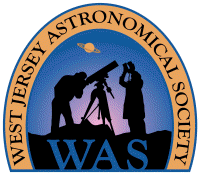SJAstro Page Index |
Mercury 2020 | Weather Links
Jupiter & Saturn Move Apart
December 27, 2020
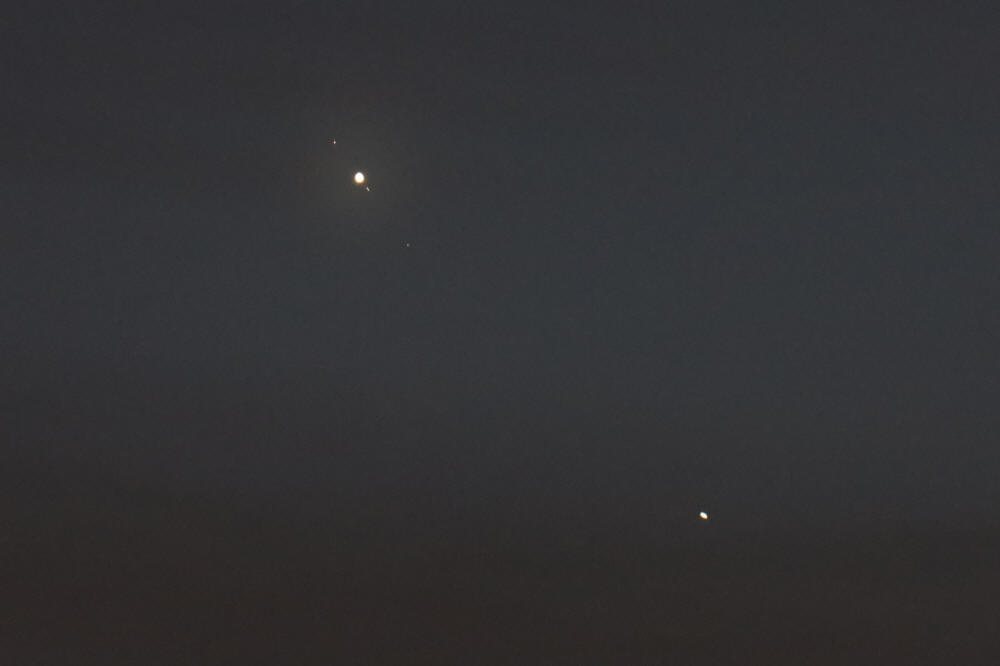
|
The "Great Conjunction" of
Jupiter
and
Saturn on December
21, 2020, has passed. On
December
27, 2020, they were about 42 arc minutes apart,
with Jupiter moving east (to the upper left in this view) at
twice the rate of Saturn (13.5 vs. 6.7 arc minutes per day
respectively) with respect to the background stars when they
were observed from the Farm Stand in Moorestown, NJ. Seeing was
poor and passing streaky clouds above the southwest horizon
interfered, but the four Galilean satellites of Jupiter and
Saturn's rings were still apparent visually with my Stellarvue 130 mm,
f/7 apo refractor. However, the North and South Equatorial Belts of
Jupiter were difficult to see on Jupiter's writhing surface.
Both planets fit comfortably in the 1.5° field of a 13.5 mm,
100° SV eyepiece (67x), but the pairing was better seen with a
20 mm, 100° SV eyepiece (46x with a 2.2° field).
Here's a tabulation of my conjunction sightings from
December 12 through 29. Here's a
photo comparison of the
separation.
The above image of them was captured at 5:35
pm, when Jupiter was a mere 10.3° altitude, using a Canon EOS RP
mirrorless digital camera at the prime focus of the 130 mm, f/7
refractor (910 mm focal length) on an alt-azimuth mount. It's a
single frame exposed 1/6 second at ISO 6400. It was cropped to
64% of the original linear dimensions for a field 1.5° wide x
1.0° high. At the time, the span of the Galilean satellites from
easternmost Ganymede (upper left) to westernmost Callisto
(bottom right) was 11 arc minutes. Mouseover for labels.
The image of Saturn below is cropped from a separate single frame
exposed 1/125 second at 5:35 pm, but otherwise the same
parameters as the frame above. It's a 300 x 200 crop from the
6240 x 4160 original for a field 6.5 x 4.4
arc minutes. The higher shutter speed reduced overexposure and
subdued some of the seeing turbulence, so instead of being
just an oval blob, the ansae formed by the rings are now visible
(albeit, this snapshot lacks any
fine detail). |
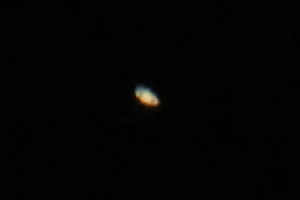
22° Solar Halo
December 23, 2020
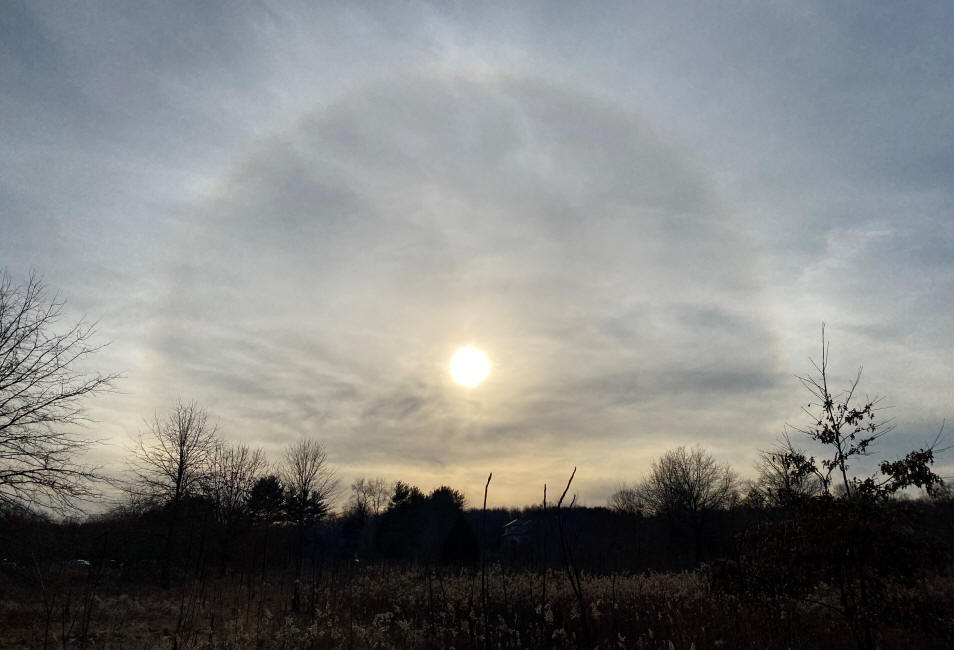
|
While taking a walk on
December
23, 2020, at Boundary Creek Park in Moorestown,
NJ, I saw a nice 22° radius
solar halo. This picture of it was taken at 2:58 pm EST with
an iPhone 11. |
Solstice Sunset,
Jupiter & Saturn Conjunction
East Point,
December 21, 2020
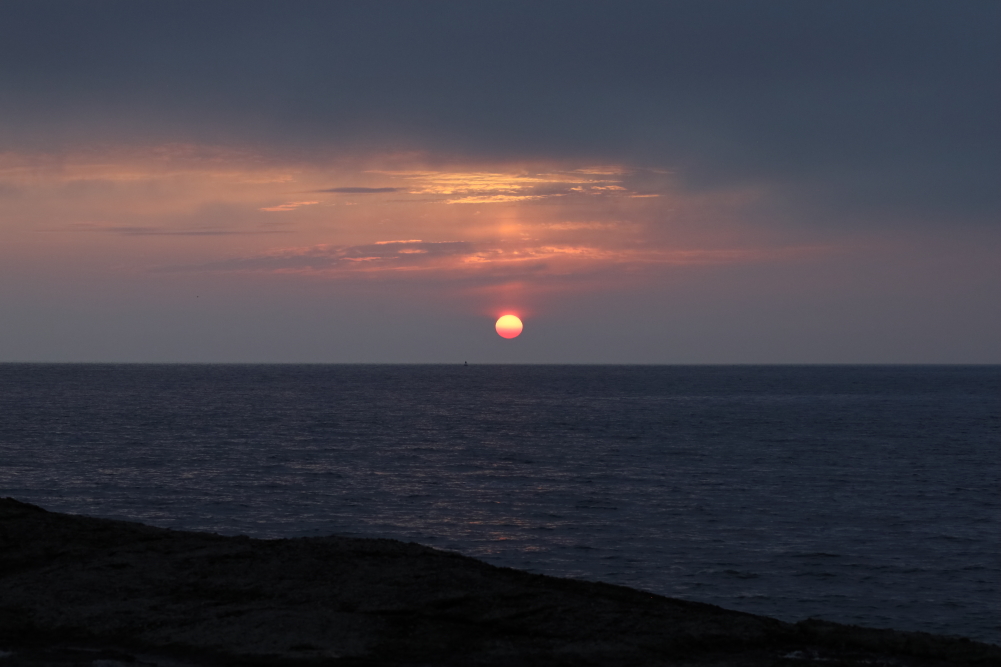
|
The two largest planets of the solar system,
Jupiter
and
Saturn, were at a close
conjunction on
December
21, 2020, which was also the day of the
Winter Solstice (for the Northern Hemisphere). Poor weather
prospects in my Maple Shade, NJ, home area prompted a trip to
East Point, NJ, in an effort to find a clear sky towards the
southwest. On arrival around 4 pm, it was gloomily overcast, but
there was a brighter band of sky along the southwest sea
horizon, so I didn't give up. Ultimately, the clouds rose away from the horizon and
the Sun appeared. Here's a view of the Sun at 0.65° altitude over
the Delaware Bay before it set at 4:41 pm EST. It's a
single-frame, handheld snapshot taken at 4:35 pm with a Canon EOS RP mirrorless
digital camera and a Canon 100 mm f/2.8 macro
lens. It was exposed 1/1000 second at f/9, ISO
1600, and is
uncropped for a field 20° wide x
14° high. |
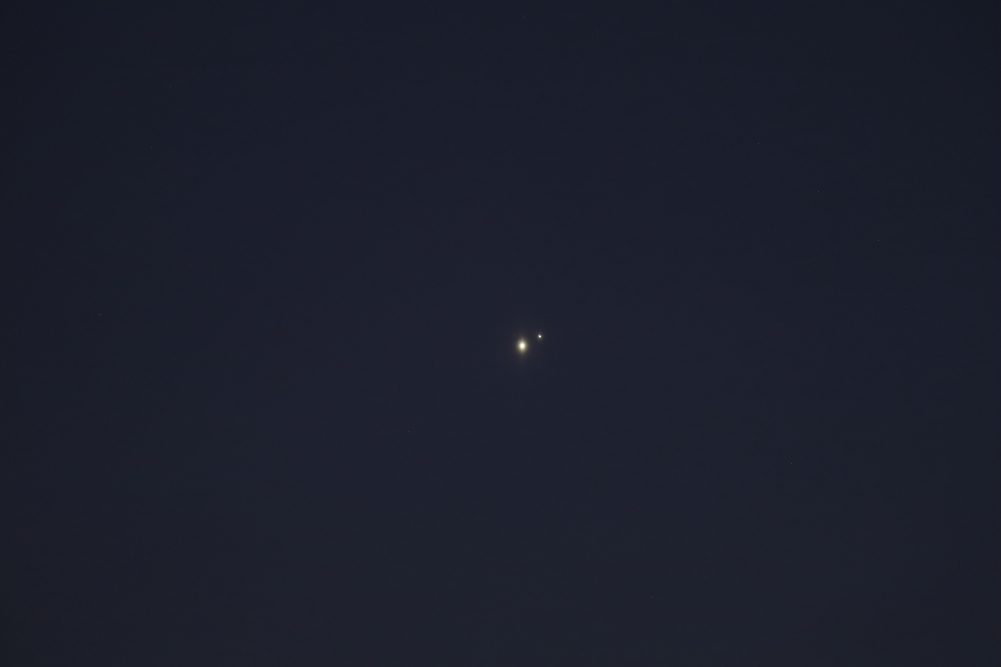
|
Some pesky broken clouds remained after sunset, but at 5:07 pm
EST, I was able to spot
Jupiter
and
Saturn in a gap
between clouds using 8x42 binoculars, then at 5:10 pm, I was
able to see both with unaided eyes. Saturn was considerably
dimmer than Jupiter, magnitude +0.6 vs. -2.0 respectively, so it
required a bit of concentration to see Saturn, whereas Jupiter
was obvious. Observed with an 88 mm apo spotting scope starting
at 5:17 pm (96x with a 49 arc minute field of view), there was more than ample space
in the field of view around the planetary pair, which were just 6'14" apart. Both the
North and South Equatorial Belts were evident on Jupiter's disc,
and all four Galilean satellites were visible; from the east
they were Callisto, Io and Ganymede. Europa was alone on the
west.
Visually, the ball of Saturn and it's
rings were clearly visible, while Saturn's brightest satellite,
Titan, was faintly visible. It was also quite evident that
Saturn's surface brightness was much less than Jupiter's. I then
swapped-out the spotting scope for the camera for a
telephoto shot of the two planets. Clouds covered the planets again
by 6 pm, and I had a brief final view of Jupiter (but not
Saturn) as it glowed dimly through a thinner patch of clouds at
6:19 pm. At that point, even the 8x42s did not reveal Saturn, let alone any
satellites.
All the while, the first-quarter Moon
shone brightly high above, and around 6 pm, it displayed a
colorful corona as the overall cloud cover thickened. Nothing
was visible in the sky when I left about 6:30 pm, and it was
getting foggy along East Point Rd as I exited.
This image
was captured on
December
21, 2020, at 5:32 pm
EST with a Canon EOS RP mirrorless
digital camera and a Canon 400 mm f/5.6 telephoto lens mounted on a fixed tripod with
a gimbal head. It was exposed 0.5 seconds at f/5.6, ISO 1600. It's
uncropped for a field 5.1° wide x
3.4° high. Jupiter is at the lower-left, Saturn is at the
upper-right. Jupiter was about 14° altitude at the time. |
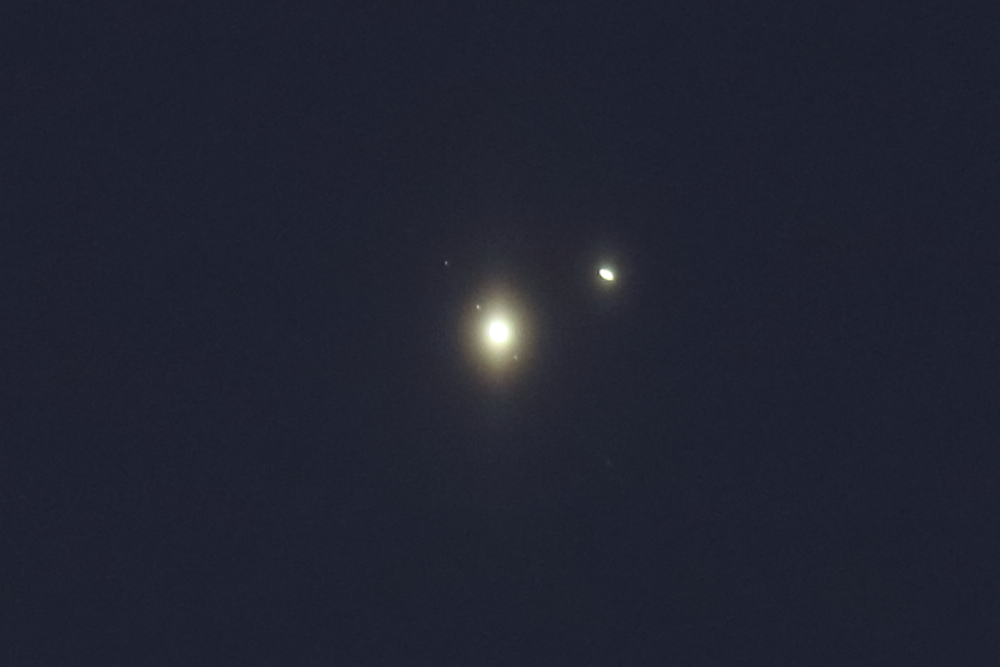
|
This picture is from the same base image as the one above, but
cropped to 16% of the original linear dimensions, to better show
Jupiter's Galilean satellites. From the upper-left (east), they are
Callisto, Io [Jupiter] and Europa. Ganymede is lost in the glare
at the upper-left of Jupiter's blurred, overexposed disc. From end-to-end, the Galilean
satellites spanned 5'58", nearly the same as the 6'14"
separation between Jupiter and Saturn. Saturn's oval shape
represents it's rings, which are not resolved from the ball
here. In addition to the planets being considerably overexposed (to insure the Jovian
satellites were recorded), the sky was becoming a bit hazy.
In the days before and after the conjunction, both planets were
in direct (or prograde) motion. Jupiter was moving eastward
(to the upper-left in this view) with respect to the background
stars at twice the rate of Saturn, hence it was catching up to,
and then eventually passed Saturn. Specifically, for +/- one day
from the conjunction on December 21, Jupiter was moving eastward
at a rate of 13.2 arc minutes per day compared to 6.7 arc
minutes per day for Saturn. |
Jupiter catching up to Saturn
December 12, 2020
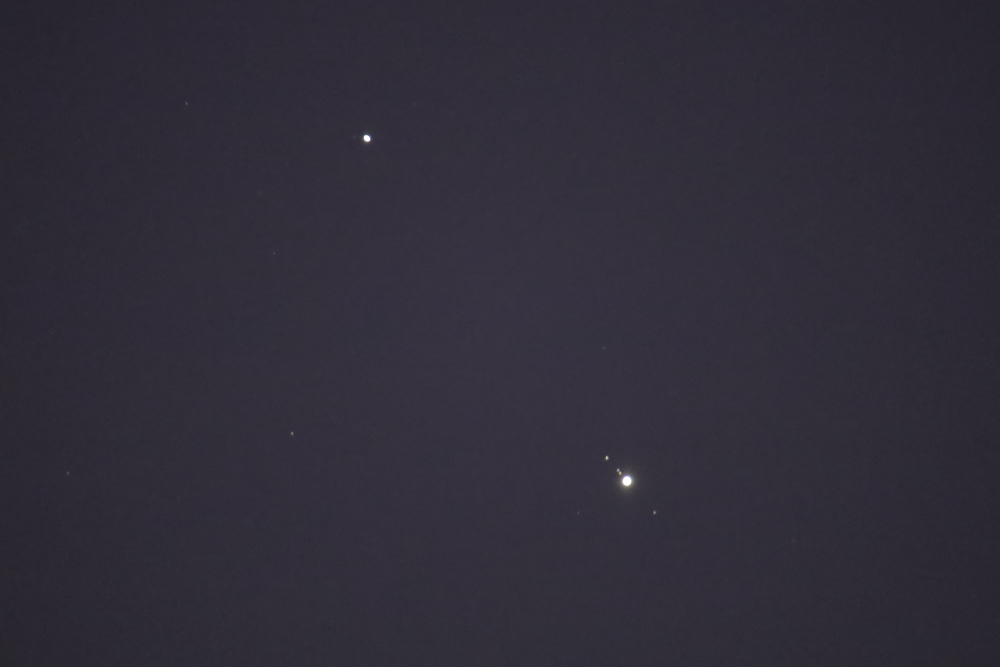
|
The two largest planets of the solar system,
Jupiter
and
Saturn, will be in
a close conjunction on December 21, 2020. This image of them
was captured on
December
12, 2020, from the baseball field complex in
Maple Shade, NJ. It's a single-frame snapshot taken at 5:36 pm
EST with a Canon EOS RP mirrorless
digital camera and a Tamron 150 to 600 mm f/5.0 to 6.3 zoom
lens, set to 600 mm focal length, mounted on a fixed tripod with
a gimbal head. It was exposed 0.4 seconds at f/6.3, ISO 6400 and
4500K white balance, then
mildly adjusted in Canon's Digital Photo Professional 4. It was
cropped to 64% or the original linear dimensions for a field 2.2° wide x
1.5° high. Mouseover for
labels.
This was mainly a test shot, preparing for the days
around conjunction and closest approach on December 21. It
was the first evening of this approach when the separation of
the two planets was less than one degree (slightly under 59 arc
minutes at the time). On December 21 after sunset, the planets
will be 6.2 arc minutes apart (center-to-center). For
comparison, the span of Jupiter's Galilean moons in this image,
from Ganymede at the upper left (east) to Callisto at the lower
right (west), is 9.9 arc minutes. Note that the planet discs are
rather overexposed, so their apparent diameters here are a bit
bloated. |
Algol at Minimum, Again
December 8, 2020
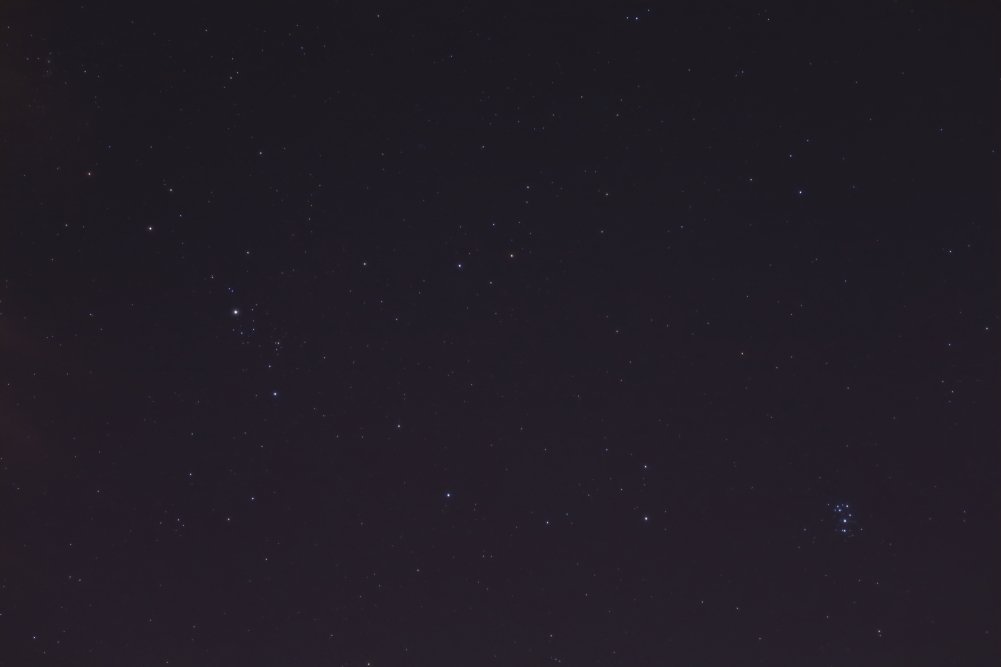
|
Another minimum of the eclipsing binary star,
Algol
(Beta Persei), was observed on the evening of
December
8, 2020, around 7:30 pm EST from Swede Run in
Moorestown, NJ. Without a moon in the sky, it was not too difficult
a target for unaided
eyes as were the minima on December 3 & 5 in a moonlit sky. Algol
experiences a sharp, but brief dip in brightness from magnitude
2.1 to 3.4 with a 2.87 day period. Sky & Telescope online has a
handy
Minima of Algol calculator which indicated this minimum
would be at 7:32 pm (SkyTools indicated 7:40 pm).
This single-frame snapshot of Perseus
was taken at 7:31 pm with a Canon EOS RP mirrorless
digital
camera mounted on a fixed tripod with a ball head and a Sigma 50 mm f/1.4 Art lens
with a Hoya "diffuser" filter. It was exposed 4 seconds at f/2.5, ISO 1250, then
mildly adjusted in Canon's Digital Photo Professional 4. The
uncropped field is 39.5° wide x 27.0° high. Mouseover for
labels; the numbers following the name/designation are the
magnitudes (without the decimal point between the first and second
numerals) obtained from SkyTools.
The purpose of the diffuser is to enlarge the stars a little to
better show brightness differences. Compare it the picture below
that was taken without a diffuser where there's little difference in
the apparent brightness of the stars. Even a little color
difference is evident here (e.g., Gorgonea Tertia has a tinge of
reddish color compared to Algol; correspondingly, the B-V values
are 1.65 and -0.05 respectively). The diffuser also takes a toll
on fainter objects; M34 is barely visible in this shot. |
Algol at Minimum
December 5, 2020
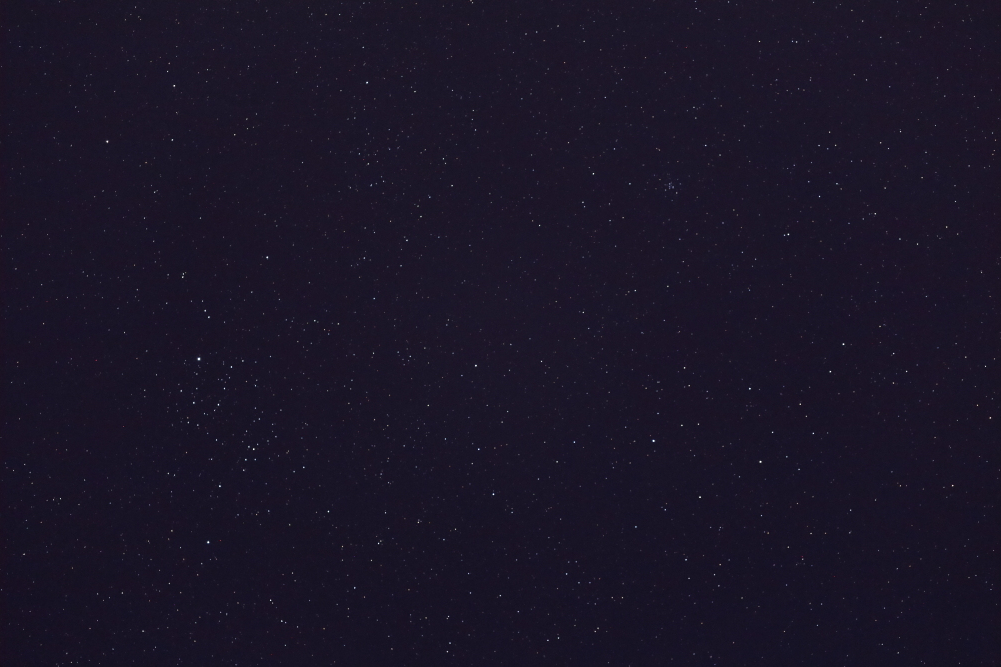
|
The eclipsing binary star,
Algol
(Beta Persei),
was observed near its minimum brightness on the evening of
December
5, 2020, around 10:45 pm EST from Swede Run in
Moorestown, NJ. It was a somewhat difficult target for unaided
eyes because of suburban light pollution and
the presence of a waning gibbous moon (70% illuminated) at about 12° altitude in
the northeast. Algol
experiences a sharp, but brief dip in brightness from magnitude
2.1 to 3.4 with a 2.87 day period. Sky & Telescope online has a
handy
Minima of Algol calculator which indicated this minimum
would be at 10:43 pm (SkyTools indicated 10:51 pm). The S&T page
also has some background information about Algol.
This single-frame snapshot of the area around Algol
was taken at 10:47 pm with a Canon EOS RP mirrorless
digital
camera and a Canon 100 mm f/2.8L macro lens mounted on a fixed
tripod with a gimbal head (the gimbal arm can tilt at a 45°
angle, allowing access to Algol's near-zenith position at
the time). It was exposed 4 seconds at f/2.8, ISO 3200, then
mildly adjusted in Canon's Digital Photo Professional 4. The
uncropped field is 20.4° wide x 13.7° high. Mouseover for
labels. Note: On December 12, I rotated
this image 180° to nominally match the orientation with the
image of December 8. |
Asteroid (8) Flora & Comet C/2020 M3 (ATLAS)
November 9, 2020
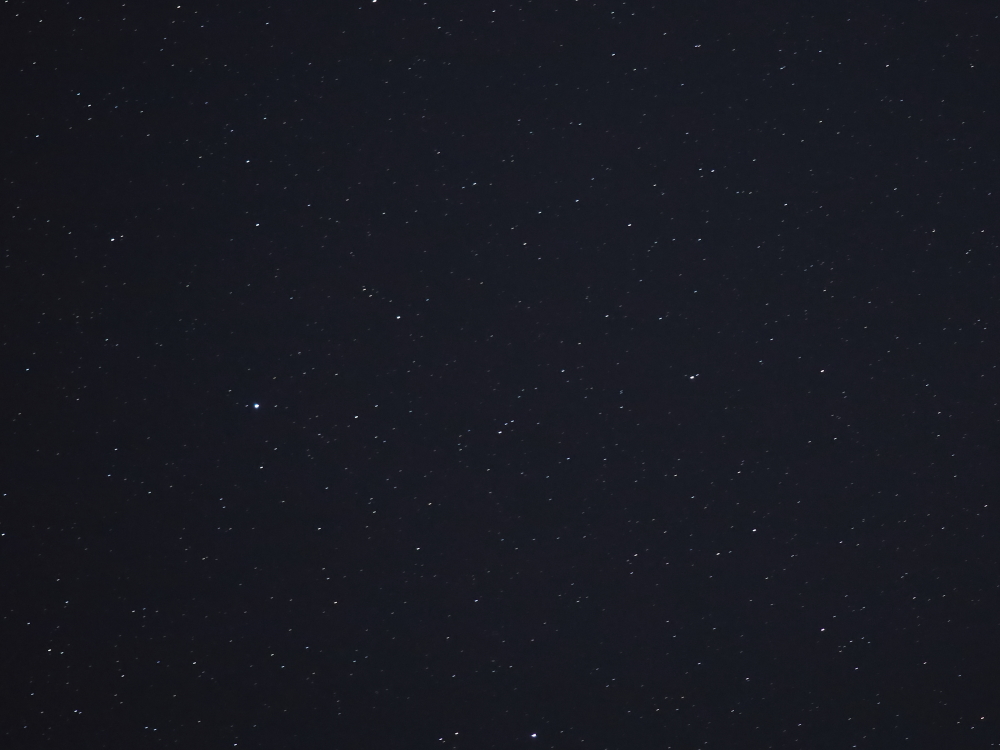
|
The minor planet, informally an asteroid,
(8) Flora
was observed on the evening of
November
9, 2020, from Carranza Field in Wharton State
Forest, NJ, with 16x70 binoculars. It was not a difficult visual
target in the constellation Cetus. Bob King has an
online article at Sky & Telescope about Flora and Uranus,
which are currently about 11° apart, with Uranus in the
constellation Aries. This view of them was captured
at 9:59 pm EST with a Canon EOS RP
mirrorless digital camera and a Canon 200 mm f/2.8L lens on a
fixed tripod. Exposed 4 seconds at f/2.8, ISO 6400, 3800K
white balance, then no further adjustments. It was cropped to a
4:3 ratio for a field 6.9° wide x
5.2° high (roughly 70% of the original frame). Mouseover for labels. |
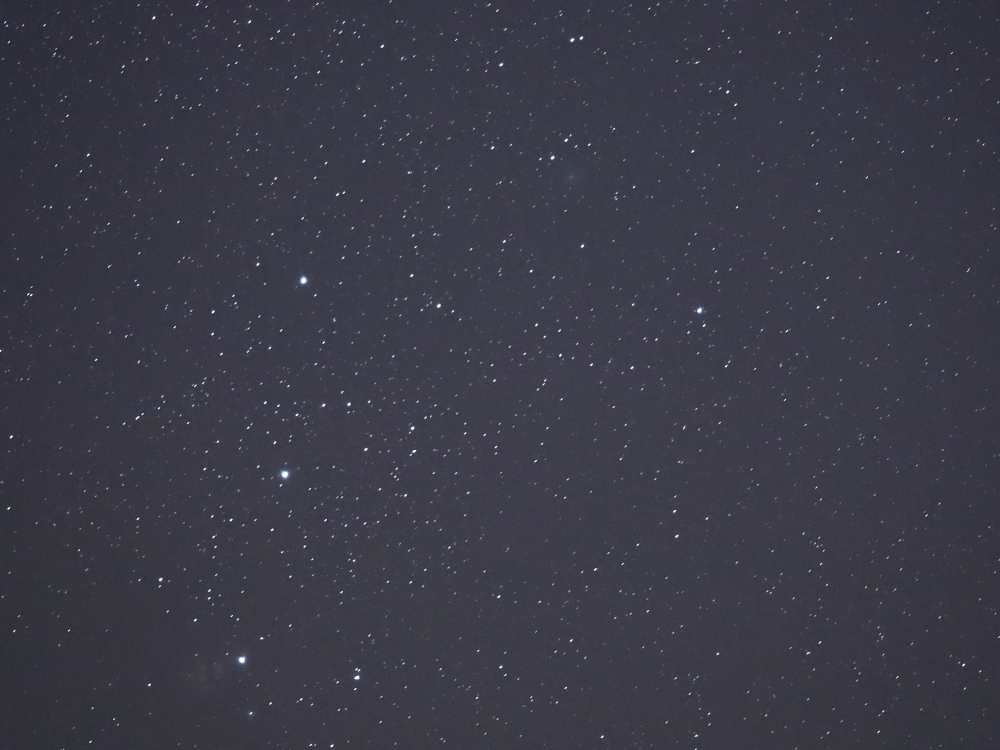
|
While not seen visually with 16x70 binoculars, I took a snapshot
in the direction of comet
C/2020 M3 (ATLAS)
on the evening of
November
9, 2020, from Carranza Field in Wharton State
Forest, NJ, at 10:06 pm EST. Taken with a Canon EOS RP
mirrorless digital camera and a Canon 200 mm f/2.8L lens on a
fixed tripod. Exposed 4 seconds at f/2.8, ISO 12,800, 3800K
white balance, with some mild adjustment in Canon's Digital
Photo professional 4, then cropped to a 4:3 ratio for a field 6.9° wide x
5.2° high (roughly 70% of the original frame). Mouseover for labels.
I went back to Carranza on
November 10 to try a visual sighting with my 88
mm apo spotting scope at a later hour so Orion would be higher
in the sky. Using 25x, I picked it up at 11:30 pm EST
without too much difficulty. When I got out my 15x56 binoculars
about 15 minutes later, I was again able to spot it without too
much difficulty. While still faint, the comet was certainly
easier to see than it was at my initial sighting on October 22,
2020 (see the second image below). With both the scope and the
binoculars, I checked my finder chart after making a
sighting to reduce the possibility that my mind was filling-in
the supposed object. The
COBS database shows that C/2020 M3 (ATLAS) is currently a
little brighter than magnitude 8, but its full diameter is
reportedly close to
that of the moon, so it has a low surface brightness. |
Venus and Mercury
November 8, 2020
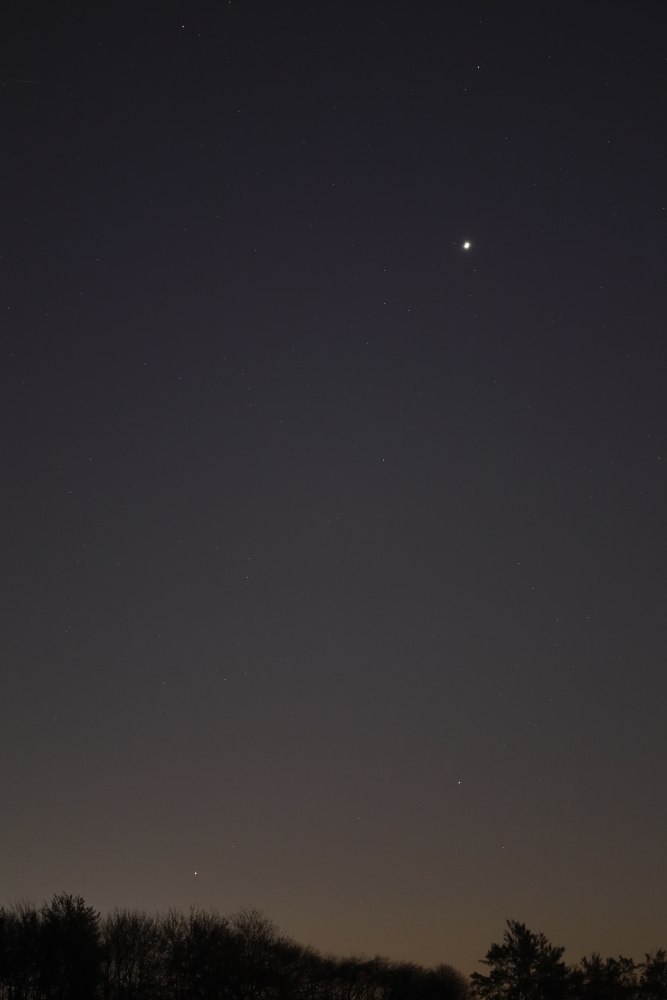
|
Venus
and
Mercury
were 14° apart, both in the constellation Virgo, at 5:25 am EST on
November
8, 2020, when this view of them was captured
from Swede Run in Moorestown, NJ. Taken with a Canon EOS RP
mirrorless digital camera and a Canon 100 mm f/2.8L macro lens
on a fixed tripod. Exposed 2 seconds at f/2.8, ISO 1600, auto
white balance with some slight adjustment in Canon's Digital
Photo Professional 4. It's uncropped for a field 13.7° wide x
20.4° high. At the time, Mercury was about 4.3° altitude, Venus
about 17° altitude. Mouseover for labels.
On the morning of November 13, 2020,
around 5:30 am EST for a nominal location of 40°N-75°W, these
two planets will be about 13° apart with the 5% illuminated
crescent moon about 6° above Mercury. |
Comet C/2020 M3 (ATLAS)
October 22, 2020
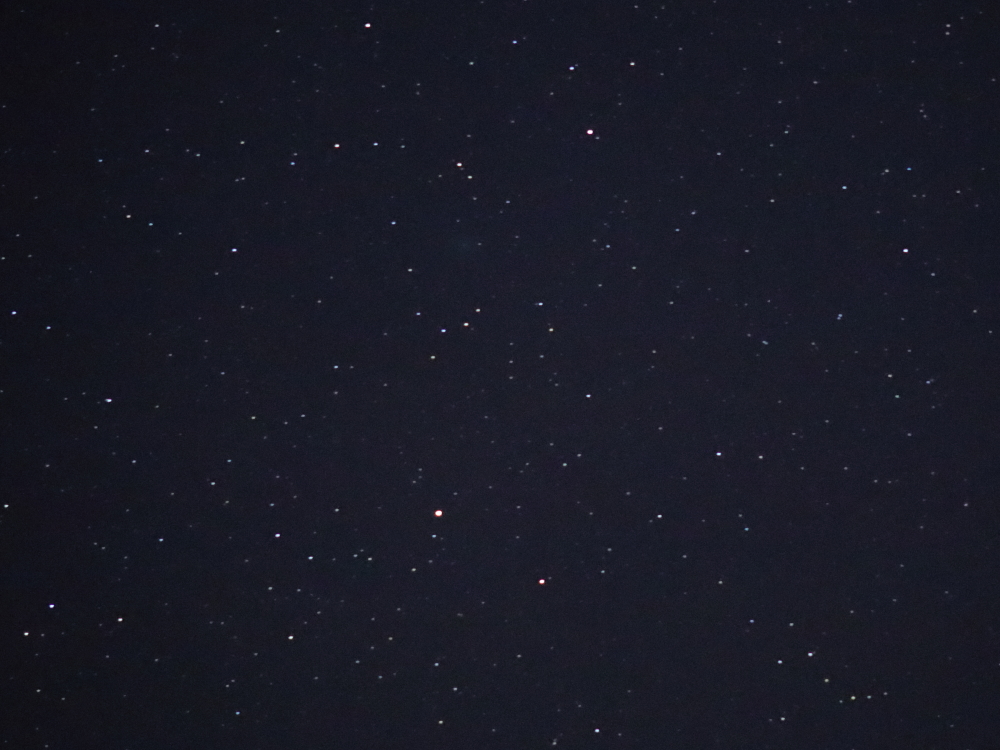
|
A wisp of Comet C/2020 M3 (ATLAS)
was captured in the image above on October
22, 2020. It was initially observed with 15x56
binoculars and an 88 mm apo spotting scope at 25x on the morning
of October 18 at Carranza Field in Wharton State Forest, NJ, but
I wanted to confirm the sighting of such a vague hazy patch, so
I went back to
Carranza, this time to the railroad crossing, on October 22. Despite
frequently
passing through fog on the way there, I continued to the RRX
where it was relatively fog-free. I made a finder chart on the
evening of October 21, but did not use it initially, I just
recollected that it was a couple of degrees above (north of) the magnitude 3.2 star,
Epsilon Leporis. After a brief scan with the 15x56s, I
saw a vague patch of haze at 3:40 am EDT, the location of which
then matched the comet's position as shown on my SkyTools finder chart.
The
COBS database indicates it is approaching eight magnitude
now.
The image above is a single frame captured
at 3:58 am with a Canon EOS RP mirrorless digital camera and a
Canon 200 mm f/2.8L lens on a fixed tripod. It was exposed 4
seconds at f/2.8, ISO 12,800, with white balance set to
3800K. It was mildly adjusted in Canon's Digital Photo
Professional 4, then cropped to about 60% of
the original frame (and a 4:3 ratio) for field 5.9° high x 4.5° wide.
Mouseover for labels.
The image below is a further crop, to a
field 1.2° wide x 1.6° high, of the previous image to better
show the faint haze of the comet's coma. Mouseover for label. |
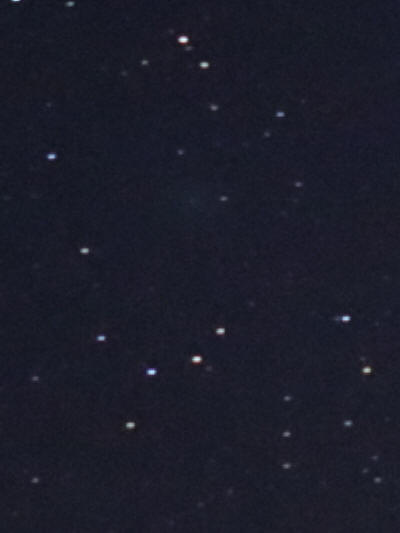
Young Crescent Moon
October 17, 2020
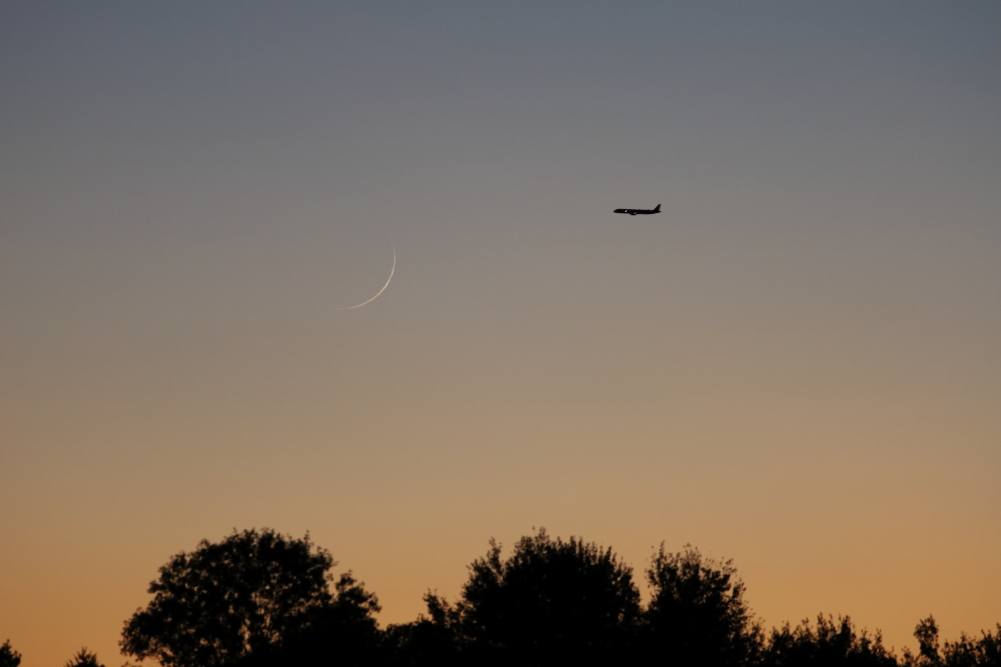
|
New Moon was on October 16, 2020, at 3:31
pm EDT, so on October 17, 2020,
the Moon was roughly 27 hours old after sunset
at 6:17 pm for this location, Swede Run in Moorestown, NJ. I was
able to spot the thin crescent, 1.9% illuminated, at 6:25 pm
with 15x56 binoculars when it was at 7.3° altitude in the WSW. I
subsequently saw the crescent with unaided eyes at 6:44 pm,
although I might have seen it sooner if I wasn't preoccupied
with my camera in the interim. The picture above was captured at
6:45 pm (3.9° altitude) using a Canon EOS RP mirrorless digital
camera with a Canon 400 mm f/5.6L telephoto lens, on a
fixed tripod, providing an
uncropped field 5.1° wide x 3.4° high. It was exposed 1/125
second at f/5.6, ISO 1600 using automatic white balance. Besides
size reduction for this web page, no processing was applied. |
Looking South towards Wallops Island, VA
from North Cape May, NJ
October 1, 2020
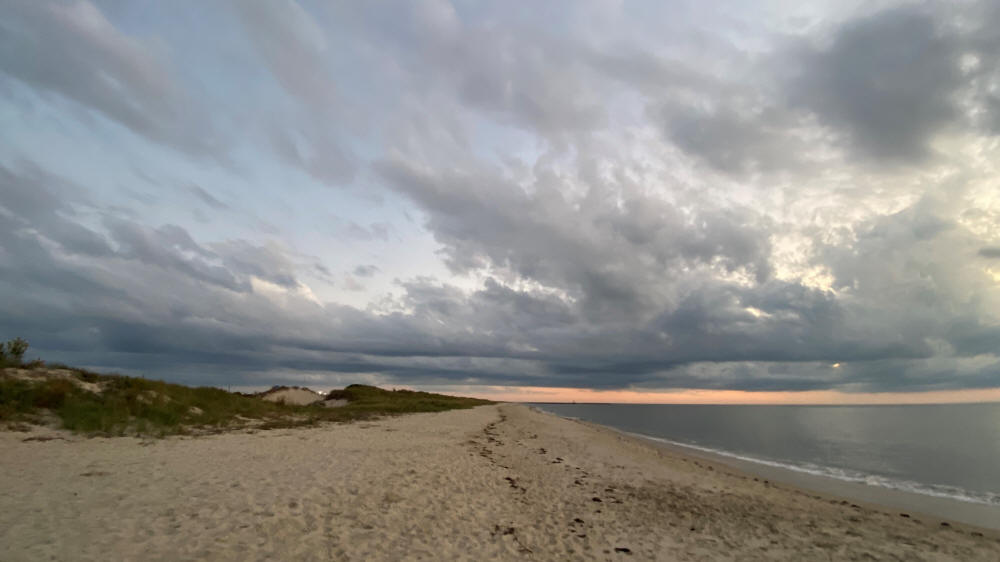
|
I travelled to Cape May, NJ, on
October 1, 2020,
with the hope of seeing the Antares rocket launch from Wallops
Island, VA, carrying the Cygnus cargo freighter to the
International Space Station. It was scheduled for 9:38 pm EDT,
so I figured in the meantime, I would take a crack at spotting
Mercury after sunset, so I went to North Cape May for a view to
the west over the Delaware Bay. The spot was about half a mile
north of the Cape May Canal and the NJ terminus of the Cape
May-Lewes Ferry. This picture, taken with an iPhone 11, looks
south about 7 pm and shows the cloud cover moving in. These
clouds precluded spotting Mercury, and ultimately, the Antares
launch, which was fortunately (for me) scrubbed by a technical
problem a couple of minutes before the scheduled ignition.
However, the weather was ideal for the
rescheduled launch at 9:16 pm on
October 2. This time, I
observed from Swede Run in Moorestown, NJ, which is about 152
miles from the launch pad at Wallops, vs. 83 miles for Cape May.
Nevertheless, we had a fine view of a bright orange dot rising
from the tree line in the SSW, which was a spectacular plume in
15x56 binoculars. It followed an arc to the left, crossing the
meridian and reaching a maximum altitude of about 20° before
the orange rocket exhaust extinguished for a minute or so as it
coasted between the first and second stages. It reappeared as a
bright white dot that started to arc downwards and vanish behind
the trees in the SE. Of course, the descent was a matter of
perspective since the rocket was still gaining altitude vs. the
earth's spheroidal surface as it headed in the direction of
Africa.
On the evening of October 3, around 7:45 pm, I was able to spot
the now-orbiting Cygnus cargo spacecraft
as it trailed the ISS by about 2¼ minutes. I used my 15x56
binoculars mounted on a tripod, spotted the ISS, locked the
position and waited for the Cygnus to cross the same field.
While considerably dimmer than the ISS, the Cygnus was still bright
enough (around magnitude +2, roughly the same as Polaris), that
it should have been visible to unaided eyes had I known better
where to look for it. Weather permitting, I hope to give it another try on the evening
of October 4. It should be closer to the ISS as it is scheduled
to dock on
October 5. Alas, the weather did not allow a sighting on
October 4. |
Click here
for the previous page.
Click here
for an index to previous SJAstro pages.
















